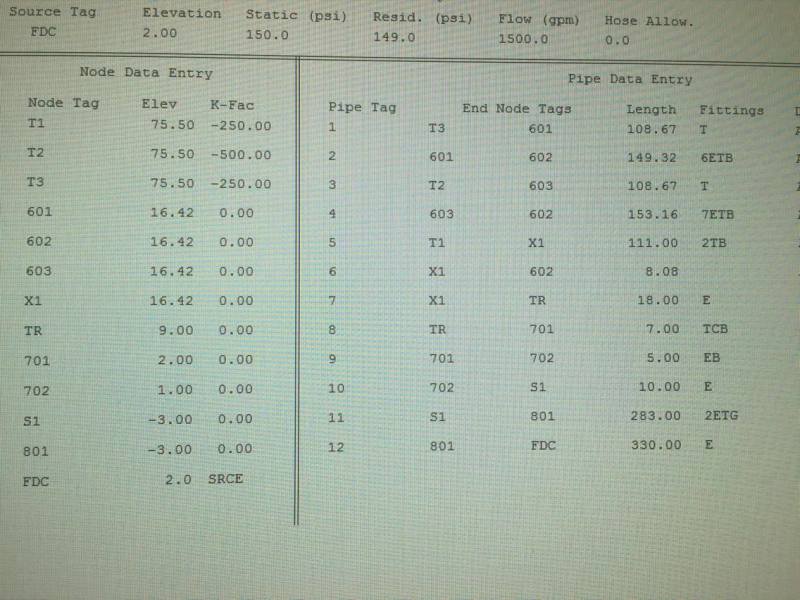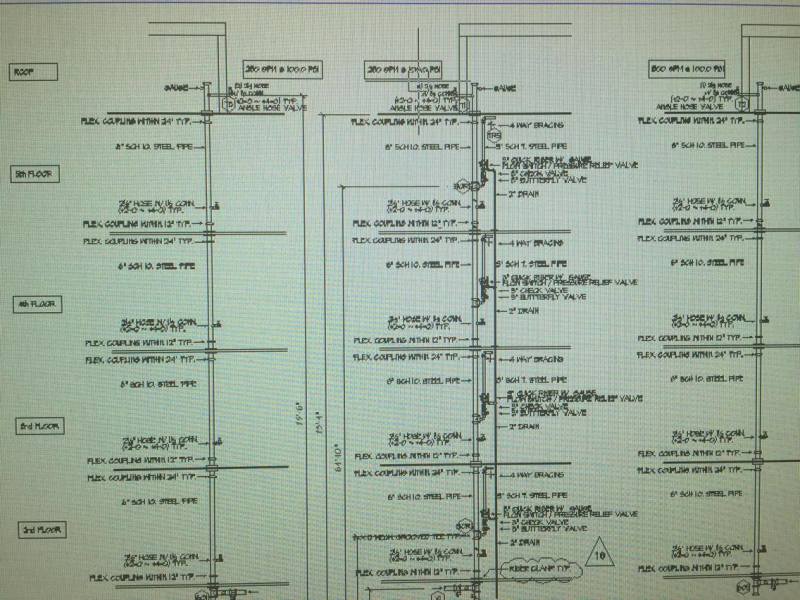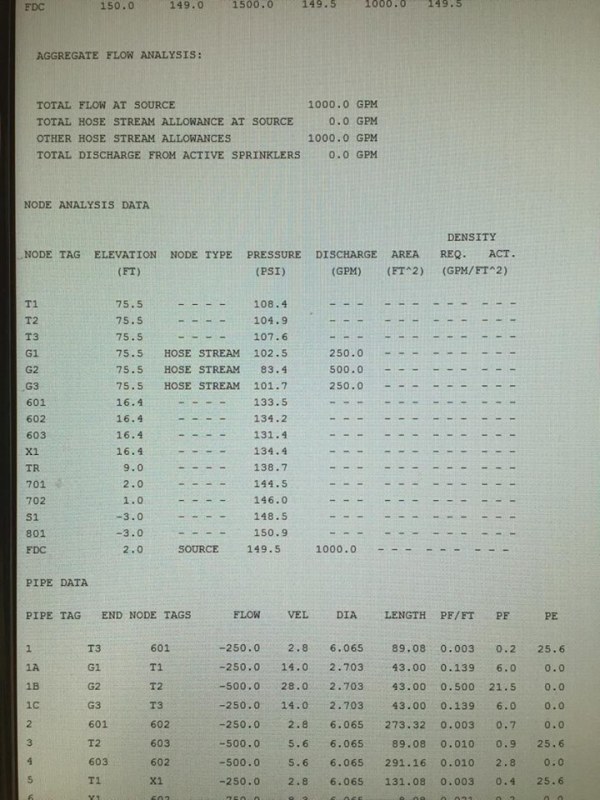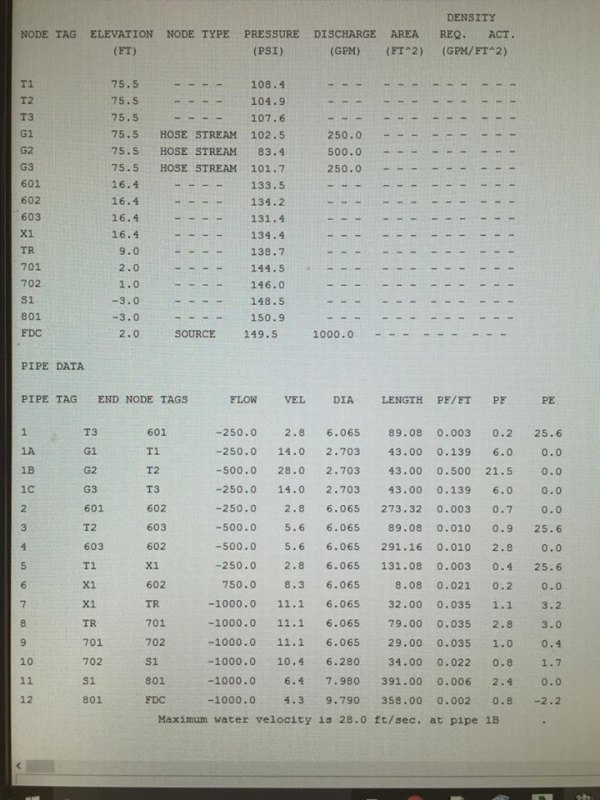Navigation
Install the app
How to install the app on iOS
Follow along with the video below to see how to install our site as a web app on your home screen.
Note: This feature may not be available in some browsers.
More options
Style variation
-
Congratulations TugboatEng on being selected by the Eng-Tips community for having the most helpful posts in the forums last week. Way to Go!
You are using an out of date browser. It may not display this or other websites correctly.
You should upgrade or use an alternative browser.
You should upgrade or use an alternative browser.
pressure loss for the hose valve
- Thread starter doingwhat
- Start date
- Status
- Not open for further replies.
TravisMack
Mechanical
Just make a node HV1 for the hose valve. Make a node O1 for outlet 1 on the standpipe. Then just enter the piping between HV1 and O1.
You can call these nodes whatever you like. This is just a very simple understanding of the program that you need in order to operate the program. It has been 15 years since I used HASS.
Heck, you could manually figure the friction loss from the valve to the outlet on the standpipe, then use that point as as your start... It's about 9.3 psi for 250 gpm to flow through 43' of 2½" sch 40. So, just use your outlet on the standpipe and start with 250 gpm @ 109.3 psi.
Good luck!!
Travis Mack
MFP Design, LLC
"Follow" us at
You can call these nodes whatever you like. This is just a very simple understanding of the program that you need in order to operate the program. It has been 15 years since I used HASS.
Heck, you could manually figure the friction loss from the valve to the outlet on the standpipe, then use that point as as your start... It's about 9.3 psi for 250 gpm to flow through 43' of 2½" sch 40. So, just use your outlet on the standpipe and start with 250 gpm @ 109.3 psi.
Good luck!!
Travis Mack
MFP Design, LLC
"Follow" us at
- Thread starter
- #3
TravisMack
Mechanical
Read NFPA 14 again. You do not flow 500 gpm through a single 2½" nipple. You flow 250 gpm at the top two outlets. As such, you may have two hose valves at the top of the remote standpipe to facilitate testing. So, your loss is only about the 9 psi that I mentioned above.
7.10.1.1.1 For Class I and Class III systems, the minimum flow rate for the hydraulically most remote standpipe shall be 500 gpm (1893 L/min), through the two most remote 21∕2 in.
(65 mm) outlets, and the calculation procedure shall be in accordance with 7.10.1.2.
I see people confuse this stuff all the time. If you go by the text, you will find it works out a lot better.
Travis Mack
MFP Design, LLC
"Follow" us at
7.10.1.1.1 For Class I and Class III systems, the minimum flow rate for the hydraulically most remote standpipe shall be 500 gpm (1893 L/min), through the two most remote 21∕2 in.
(65 mm) outlets, and the calculation procedure shall be in accordance with 7.10.1.2.
I see people confuse this stuff all the time. If you go by the text, you will find it works out a lot better.
Travis Mack
MFP Design, LLC
"Follow" us at
TravisMack
Mechanical
Do you have a copy of NFPA 14? There is a section on testing that you may want to review. If you don't have the copy, you can access the codes/standards online for free at NFPA website.
I will say that most AHJs will waive the requirement.
11.5.1* The standpipe system shall be tested to verify system demand.
A.11.5.1 The hydraulically most remote hose connections in a building are generally at a roof manifold, if provided, or at the top of a stair leading to the roof. In a multizone system, the testing means is generally at a test header at grade or at a suction tank on higher floors. Where a flow test at the hydraulically most remote hose connection is not practicable, the AHJ should be consulted for the appropriate location of the test.
11.5.1.1 The test required by 11.5.1 shall be permitted to be waived where acceptable to the AHJ.
11.5.1.2 This test shall be conducted by flowing water simultaneously from the outlet(s) indicated in the approved hydraulic calculations of each standpipe as required by Sections 7.8 and 7.10.
11.5.1.2.1 For each additional standpipe, the required flow shall be permitted to be taken from any hose connection on that standpipe.
11.5.2* For a manual standpipe, a fire department pumper,portable pump of a capacity to provide the required flow and pressure, or other approved means shall be used to verify the
system design by pumping into the fire department connection.
11.5.2.1 Where allowed by the authority having jurisdiction, the test required by 11.5.2 shall be permitted to be waived.
A.11.5.2 It is not always necessary to use a pump to test a standpipe system. See Figure A.11.5.2(a), Figure A.11.5.2(b), and Figure A.11.5.2(c) for examples of possible test methods.
Where using the method shown in Figure A.11.5.2(c), it is necessary to flow the system demand while observing the pressures at the FDC inlet and the hydraulically remote standpipe
hose valve. While the standpipe test might indicate that a greater pressure is required at the FDC inlet than what was indicated in the hydraulic calculations, this is not necessarily a cause for failing the test. This greater pressure, if acceptable to the AHJ based on the ability of the fire apparatus to provide the additional pressure, should be incorporated into the stand‐pipe sign required at the FDC by 6.4.5.2.2.
NFPA 25 also requires flow testing of standpipes every 5 years.
6.3.1.1* A flow test shall be conducted every 5 years on all Class I and Class III standpipe systems to verify that the required flow and pressure are available at the hydraulically most remote hose valve outlet(s) while flowing the standpipe system demand.
So, my statements above on how to handle the issue you have are in full compliance with NFPA 14 and facilitate the requirements of NFPA 25.
Travis Mack
MFP Design, LLC
"Follow" us at
I will say that most AHJs will waive the requirement.
11.5.1* The standpipe system shall be tested to verify system demand.
A.11.5.1 The hydraulically most remote hose connections in a building are generally at a roof manifold, if provided, or at the top of a stair leading to the roof. In a multizone system, the testing means is generally at a test header at grade or at a suction tank on higher floors. Where a flow test at the hydraulically most remote hose connection is not practicable, the AHJ should be consulted for the appropriate location of the test.
11.5.1.1 The test required by 11.5.1 shall be permitted to be waived where acceptable to the AHJ.
11.5.1.2 This test shall be conducted by flowing water simultaneously from the outlet(s) indicated in the approved hydraulic calculations of each standpipe as required by Sections 7.8 and 7.10.
11.5.1.2.1 For each additional standpipe, the required flow shall be permitted to be taken from any hose connection on that standpipe.
11.5.2* For a manual standpipe, a fire department pumper,portable pump of a capacity to provide the required flow and pressure, or other approved means shall be used to verify the
system design by pumping into the fire department connection.
11.5.2.1 Where allowed by the authority having jurisdiction, the test required by 11.5.2 shall be permitted to be waived.
A.11.5.2 It is not always necessary to use a pump to test a standpipe system. See Figure A.11.5.2(a), Figure A.11.5.2(b), and Figure A.11.5.2(c) for examples of possible test methods.
Where using the method shown in Figure A.11.5.2(c), it is necessary to flow the system demand while observing the pressures at the FDC inlet and the hydraulically remote standpipe
hose valve. While the standpipe test might indicate that a greater pressure is required at the FDC inlet than what was indicated in the hydraulic calculations, this is not necessarily a cause for failing the test. This greater pressure, if acceptable to the AHJ based on the ability of the fire apparatus to provide the additional pressure, should be incorporated into the stand‐pipe sign required at the FDC by 6.4.5.2.2.
NFPA 25 also requires flow testing of standpipes every 5 years.
6.3.1.1* A flow test shall be conducted every 5 years on all Class I and Class III standpipe systems to verify that the required flow and pressure are available at the hydraulically most remote hose valve outlet(s) while flowing the standpipe system demand.
So, my statements above on how to handle the issue you have are in full compliance with NFPA 14 and facilitate the requirements of NFPA 25.
Travis Mack
MFP Design, LLC
"Follow" us at
Thanks Travis,
I always for some reason associated testing when it came to PRVs. I would say I never ran into the situation where we physically had to "prove" the calc by testing the standpipe system. Thanks for the time you spent replying to my question.
I always for some reason associated testing when it came to PRVs. I would say I never ran into the situation where we physically had to "prove" the calc by testing the standpipe system. Thanks for the time you spent replying to my question.
TravisMack
Mechanical
No problem. Cut and paste is really easy ![[bigsmile] [bigsmile] [bigsmile]](/data/assets/smilies/bigsmile.gif)
I have only known of a handful of jurisdictions across the country that require the testing.
Travis Mack
MFP Design, LLC
"Follow" us at
![[bigsmile] [bigsmile] [bigsmile]](/data/assets/smilies/bigsmile.gif)
I have only known of a handful of jurisdictions across the country that require the testing.
Travis Mack
MFP Design, LLC
"Follow" us at
TravisMack
Mechanical
LMAO!!! Lots of long hours working. Also, this forum has actually provided a few clients over the years. So, I learn a ton on here, help out when I can, and just happen to get a customer or two. It is a win-win all the way around.![[thumbsup2] [thumbsup2] [thumbsup2]](/data/assets/smilies/thumbsup2.gif)
Travis Mack
MFP Design, LLC
"Follow" us at
![[thumbsup2] [thumbsup2] [thumbsup2]](/data/assets/smilies/thumbsup2.gif)
Travis Mack
MFP Design, LLC
"Follow" us at
- Status
- Not open for further replies.
Similar threads
- Replies
- 6
- Views
- 5K
- Replies
- 8
- Views
- 5K
- Replies
- 1
- Views
- 3K
- Replies
- 3
- Views
- 4K
- Replies
- 3
- Views
- 592






![[wink] [wink] [wink]](/data/assets/smilies/wink.gif)